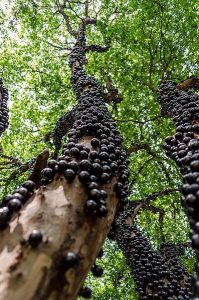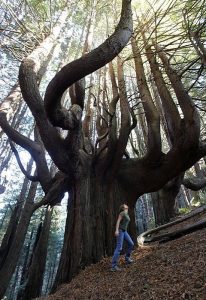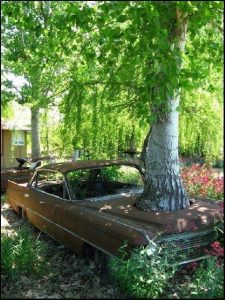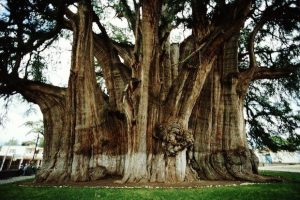





Photo: National Parks Conservation AssociationThere’s something romantic about the image of two young valentines, in an idyllic pastoral scene, etching their initials in the side of a tree to commemorate their affection, but tree carving isn’t just for lovers. In a burgeoning field of archeological study, researchers are looking to some of the world’s oldest tree carvings, known as arborglyphs, to better understand the peoples and traditions of cultures past — and most are a lot more interesting than just a heart with an arrow through it.

Photos: Basque Library, University of Nevada, RenoAccording to archeologists, the of carving shapes and symbols into living trees has likely been practiced by civilizations throughout the world, though very few culturally modified trees dating back more than a few hundred years still remain. Since arborglyphs are etched into living wood, they’re lifespan is typically limited to that of the tree — so unlike petroglyphs, which can date back thousands of years, tree carvings are among the most fleeting artifacts of past cultures that exist.
Perhaps the most studied arborglyphs are the ones produced by Basque immigrants who left their native Pyrenees Mountains to work as shepherds throughout the western United States beginning in the mid-19th century. Because their occupation would have them alone for months at a time in some of the most remote forests, they took to perfecting the art of tree carving — leaving behind drawings and poetry delicately etched into the wood as living artifacts.

Photo: The Society of Environmental JournalistsThe nation’s foremost expert of arborglyphs is Basque history Professor Joxe Mallea-Olaetxe of the University of Nevada. Over the last several decades, he has recorded around 20,000 tree carvings across California, Nevada, and Oregon dating back to the turn of the last century.
“It’s mostly history. For me that’s what they are,” says Mallea-OlaetxeIf told the Sacramento News-Review. “We didn’t have these carvings, how would you know who was herding sheep on this mountain, for example. There is nothing written on that. The Basque country, being very small, and the Basque people being very few, it is important for them to know where everybody went and where they herded, how long, all of those things. And the only information comes from the trees.”

Photo: Ken ProperFor the shepherds, the smooth, white bark of aspens proved the best natural canvases. With a knife, or even a fingernail, the artist could scratch off a thin layer of bark to form words or images. At first, their carvings would be difficult to see, but in time the tree’s healing process darkens the markings, making them stand out against the pale wood.
“It is the tree who does the carving, not the herder,” says the Professor. “The herders did not really do this carving other than the very initial, and how it would look 20 years down the road, they had no idea.”
Unfortunately, since aspens typically only live around 100 years, most remaining examples only date back that far. Still, researchers have found even old arborglyphs in fallen and standing-dead trees.

Photo: University of NevadaWhile tree carving is thought of a lovers’ pastime, those studied by archeologists are quite different. The quality and subject matter of the arborglyphs ranges from simply dates and names to elaborate drawings of often explicit sexual imagery, but they all seem to point to the effects of solitude on the shepherds. To U.S. Forest Service heritage expert, Angie KenCairn, the aspen art reflects the deepest longings of folk engaged in one of the most socially isolating occupations.

Photo: Delirious Ramblings“Sometimes they just tear at your heart. They were lonely men. That’s obvious from the sheer number of women they drew. One carving reads, ‘Es trieste a vivir solo,’ (It’s sad to live alone). That’s tough. It’s why herding sheep isn’t a job that many people want to do,” KenCairn told Steamboat Magazine.
Professor Mallea-Olaetxe, who has devoted his academic life to documenting the arborglyphs, time is running for many groves where they remain. Wildfires, disease, and natural deterioration threaten the untold number of tree carvings yet to be assessed, threatening to destroy the living remnants of a cultural legacy stretching back for well over a century.

Photo: Alex WierbinskiAlthough there is much to learn from the history preserved in the aging arborglyphs, conservationists generally discourage others from carving trees. Aside from being regarded as ‘graffiti’ in many cases, the practice could also prove lethal to the tree. Deep gouges into a tree’s trunk, like in skin, makes the tree more susceptible to diseases and pests.
While the lonely shepherds at the turn of the last century may have perfected the art of tree carving, perhaps nowadays the most romantic way for young valentines to commemorate their love is to leave things as they are.
The same applies to tree-carving pranksters whose trickery threatens to throw archeologists off by a few hundred-thousand years.

Photo via Utah Wildlife Network
More on Art in Nature
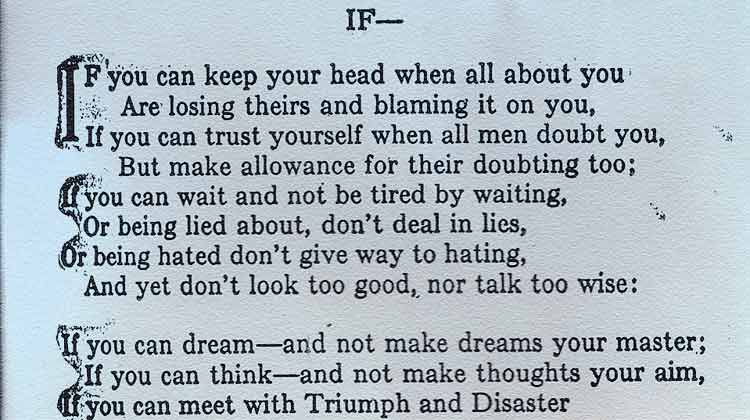
If you can keep your head when all about you Are losing theirs and blaming it on you; If you can trust yourself when all men doubt you, But make allowance for their doubting too; If you can wait and not be tired by waiting, Or, being lied about, don’t deal in lies, Or, being hated, don’t give way to hating, And yet don’t look too good, nor talk too wise; If you can dream—and not make dreams your master; If you can think—and not make thoughts your aim; If you can meet with triumph and disaster And treat those two impostors just the same; If you can bear to hear the truth you’ve spoken Twisted by knaves to make a trap for fools, Or watch the things you gave your life to broken, And stoop and build ‘em up with wornout tools; If you can make one heap of all your winnings And risk it on one turn of pitch-and-toss, And lose, and start again at your beginnings And never breathe a word about your loss; If you can force your heart and nerve and sinew To serve your turn long after they are gone, And so hold on when there is nothing in you Except the Will which says to them: “Hold on”; If you can talk with crowds and keep your virtue, Or walk with kings—nor lose the common touch; If neither foes nor loving friends can hurt you; If all men count with you, but none too much; If you can fill the unforgiving minute With sixty seconds’ worth of distance run— Yours is the Earth and everything that’s in it, And—which is more—you’ll be a Man, my son!

OCTOBER 08, 2017 07:55 AM
UPDATED OCTOBER 08, 2017 07:55 AM
When the art pieces along what used to be Fulton Mall were removed in April 2016 to make way for the bulldozers, folks were skeptical.
Mistrustful, even.
As Andrea Morse, the art conservator hired to curate the sculptures as part of the Fulton Street Restoration Project, discovered firsthand.
“Every time we were out here, someone would say, ‘Why are you removing the art? Are they selling it?’ ” Morse said with a shake of her head. “I kept having to tell them we’re bringing everything back. ‘Yeah, right’ is what we’d hear.”
The skepticism isn’t unfounded.
Fresno, after all, has a sorry track record when it comes to maintaining and showcasing its public art. So much so that in 1999 the Fresno County grand jury publicly scolded city officials over the “woeful neglect” of the sculptures and fountains entrusted to their care.
“Where once we marveled at the excellence and dignity of this exhibition,” the grand jury report stated, “it is now viewed with dismay and alarm.”
THERE WAS INCREDIBLE MISTRUST AND CYNICISM ON HOW THE ART WOULD BE HANDLED ALL THE WAY THROUGH THE PROCESS.
Craig Scharton, Downtown Fresno Partnership
Seventeen years and $5 million later (about 25 percent of the Fulton Street project’s total budget), that sad chapter can finally be shut. Fresno can once again marvel at its sculptures and fountains, view them with contentment and comfort.
Each of the 19 artworks has been restored and reinstalled close to its original positions in anticipation of Fulton Street’s Oct. 21 grand opening. (Two exceptions: the 60-foot tall wooden “Clock Tower,” still being refurbished after it was moved 30 feet by crane; and “La Grande Laveuse,” a bronze sculpture of a washer woman by French impressionist painter Pierre Auguste Renoir and one of only six in existence. She will be placed last.)
What a transformation. To people like me, whose only familiarity with these works came during their neglected state, the results are astonishing.
It took a lot of time, angst and the public holding city leaders accountable, but downtown Fresno now has a glistening display of public art everyone can enjoy and take pride in.
Hopefully, we take care of it this time around.
“I think everybody in Fresno, everybody around Fresno and everybody who drives through Central California should stop here and see what beautiful California art is,” Morse said.
The collection, purchased by private donations of nearly $250,000 one year after the mall’s 1964 completion and transferred to city ownership, hasn’t glistened like this in decades.
The bronze statues were cleansed of dirt, grime and dreaded calcium buildup using a painstaking process that starts with washing with PH-balanced biodegradable soap, moves to scraping with Popsicle sticks and continues with gentle scouring.
Chemical treatments are the final step, and only if necessary. The exterior of “Ellipsoid VI,” a brass fountain that was the most discolored of the entire collection, also required a new hot patina surface, which Morse and her staff at Sculpture Conservation Studio in Los Angeles color-matched to the underside.
Equally in need of TLC were the 24 mosaic “Pipes” by Fresno artist Stan Bitters that adorn four separate fountains situated along the six-block area. Some of the ceramic pieces (especially the ones at Fulton and Inyo streets) had been smashed and defaced by vandals.
“They gave me a basket full of broken-off parts – it was like a jigsaw puzzle,” Morse said. “And sometimes there were little voids that needed to be filled in.”
THE PIPES WERE SO FILTHY. THERE WERE RUBBER GLOVES. THERE WERE SYRINGES. THEY WERE JUST HORRIBLE THINGS INSIDE THERE THAT WE HAD TO CLEAN OUT.
Andrea Morse, Fulton Street art conservator
The pipes were all heavily coated with minerals, which faded their once-vibrant colors and required hours of tedious labor to remove. Each then had to be repainted. Morse used an old photograph to match the original blue and brown hues, but not before sending in the color chart for city approval.
“I followed the exact design (Bitters) used,” she said. “Same colors, same pattern, everything.”
Morse estimates she spent “about a year” restoring the pipes, which take their inspiration from irrigation standpipes that dot Valley farms, calling them her “pet project.”
“I look at them all the time, and I clean them up,” Morse said. “They tell me, ‘You’re not supposed to clean them up.’ I can’t help it because they’re my baby. I’m very proud of them, and I think they came out very, very beautiful.”
Integral to the presentation of several sculptures are 16 new fountains and pools built by California Waters of Yorba Linda using landscape architect Garrett Eckbo’s original designs. (Sizes have changed to fit their new locations.) Each fountain uses recirculated, treated water and all have new pumps, filters, electrical panels and light fixtures for nighttime appreciation.
The biggest beneficiary is “Dancing Waters,” a concrete fountain by Bitters that formerly stood as a mall centerpiece near Fresno Street but has been drained in recent years because it leaked into the basement of nearby buildings.
The fountain now occupies the newly created Kern Plaza behind Chukchansi Park, alongside Claire Falkenstein’s three abstract depictions of fire that were removed from the mall in 2013 due to repeated vandalism by metal thieves. (These are especially cool at night, when lit up.) “Dancing Waters” has been repainted and now sits in a larger pool to reduce splashing.
When possible, the original artists (and in some cases their descendents) were invited to take part in the restoration of their works or at least give input. Some chose to do so, while others declined.
Bitters, who still lives in town and remains an active artist, was in the latter group. The 81-year-old said he saw his restored sculptures on the news but has no plans to view them in person. Not even when I told them how spectacular they looked and volunteered to pick him up and drive him down there myself.
When asked why he feels that way, Bitters launched into a passionate defense of the Fulton Mall and critique of the city’s role in letting both it and the public art deteriorate.
“I’ve given up on Fresno,” Bitters concluded.
Not everyone has. Fellow local artist Joyce Aiken, who along with Jean Ray Laury created the mosaic bench backs that have been reinstalled along Fulton Street, recently spent an afternoon re-grouting and replacing missing tiles.
$5 millionamount budgeted for art in the Fulton Street Renovation Project
Although Aiken still believes the city made a mistake ripping out the pedestrian mall, the 86-year-old is pleased with what she sees.
“The company that restored the art did a remarkable job,” Aiken said. “It’s so nice to see everything back close to the original style.”
Now that Fresno can once again be proud of its public art, it’s up to all of us, City Hall and its citizenry, to keep things looking that way.
The City has a responsibility to maintain its assets, but at present no contracts have been signed for their long-term upkeep. This is something we cannot afford let slip. Nor is the collection being adequately protected. When paring down the budget for Fulton Street reconstruction, security cameras for the art was one of the last items to be trimmed.
According to Craig Scharton, interim president of the Downtown Fresno Partnership, any leftover money in the $20 million project’s contingency fund will be used to purchase those cameras. However, city spokesman Mark Standriff indicated those dollars are needed to cover last-minute construction issues.
This is a problem in waiting for an art collection valued at several million.
“I’ll be honest: You need (cameras),” said Mike Cuicchi, California Waters’ director of construction. “You put brass in a fountain, or any valuable metal, and it tends to disappear.”
At one time, public art on the Fulton Mall was a regional treasure. Then, due to neglect and disinterest, it became a regional embarrassment. Now the script has been flipped with the sculptures and fountains getting a fresh start in a new, hopefully improved version of downtown.
Go enjoy your birthright, Fresno. Sit beside these works, soak them in and let them elevate your thoughts and senses. Maybe even shelve the skepticism, at least for a bit.
Marek Warszawski: 559-441-6218, @MarekTheBee

By Amanda Froelich Truth Theory
When linguists talk about the historical relationship between languages of the world, they oftentimes use a tree metaphor. The textbook version tends to be drab and boring, however, which is why Minna Sundberg, the creator of the webcomic Stand Still. Stay Silenttook the time to create a much more imaginative version.
Arika Okrent of Mental Floss writes, “An ancient source (say, Indo-European) has various branches (e.g., Romance, Germanic), which themselves have branches (West Germanic, North Germanic), which feed into specific languages (Swedish, Danish, Norwegian).
Now, a much more enticing version of the simple tree diagram has been created. For understandable reasons, it has gone viral:


If you know the location of any of these trees please let us know!

